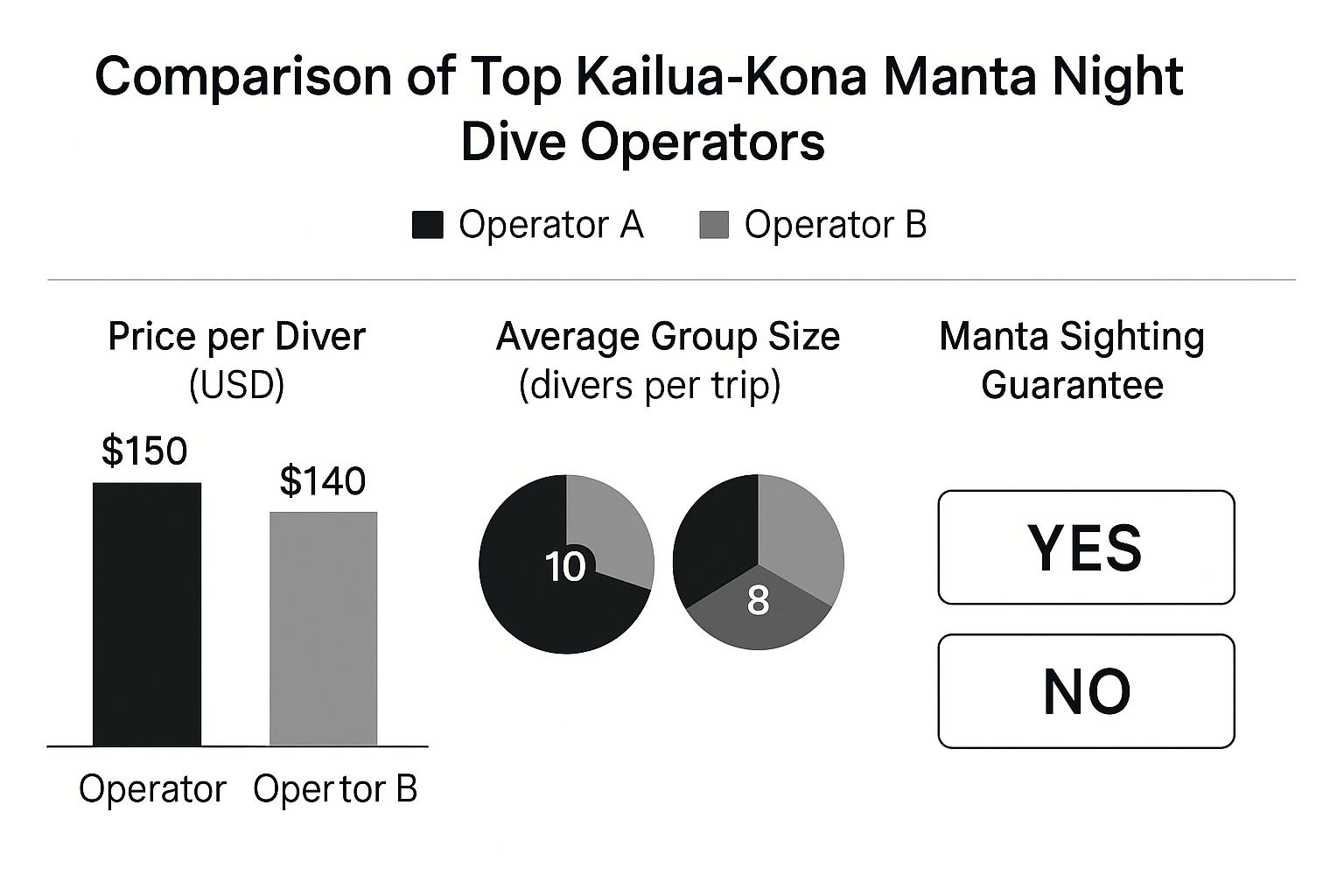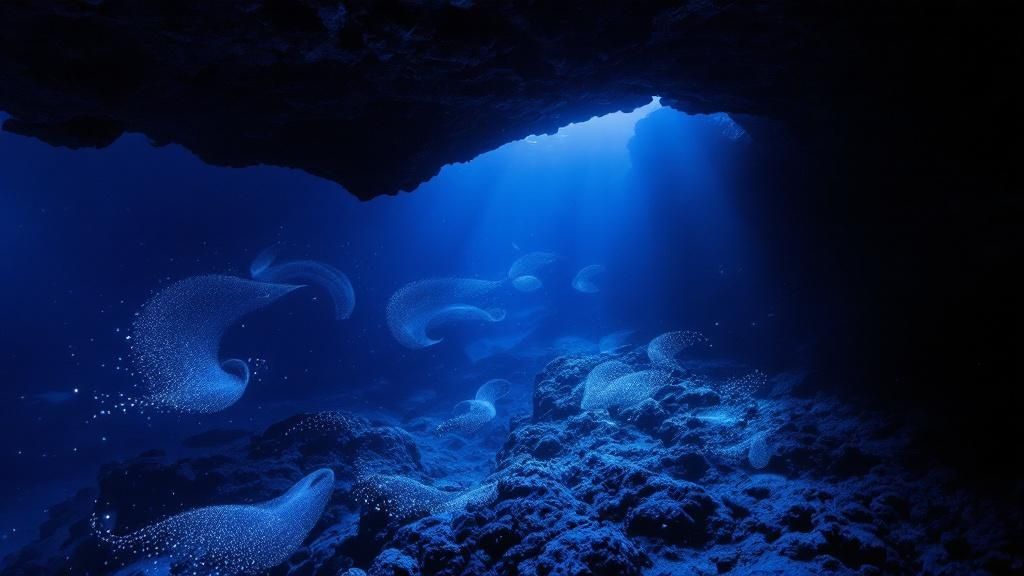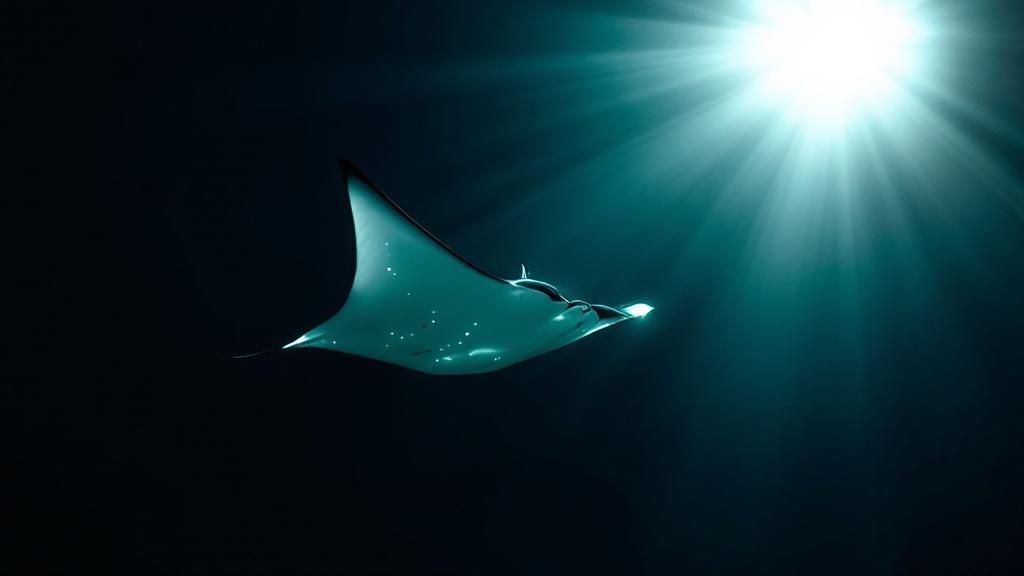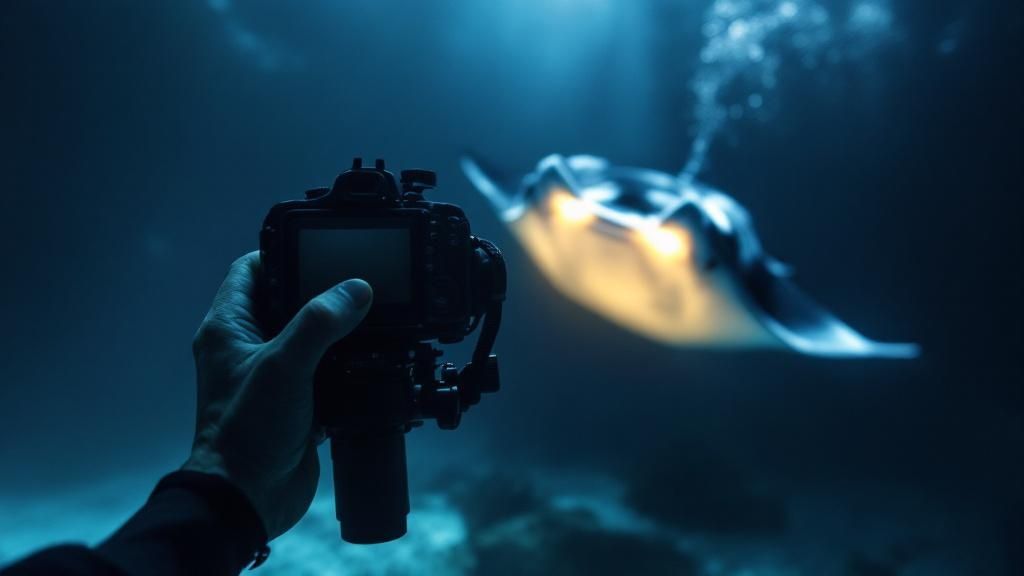Why Kailua Kona Reigns Supreme For Manta Ray Encounters
Kailua Kona, Hawaii, isn't just a beautiful destination; it's the world's premier location for manta ray night dives. This isn't by chance. Kona boasts a unique combination of natural factors that create a true manta ray paradise. The volcanic coastline provides easy access to deep ocean waters rich in nutrients. These nutrient-rich currents fuel plankton blooms, the manta rays' primary food source. Kona's sheltered bays and coves also offer protection from strong currents and rough seas, creating a calm and predictable environment for both mantas and divers.
These plankton blooms are essential to Kona's thriving manta ray population. The island's volcanic slopes descend sharply into the deep ocean, allowing nutrient-rich waters to rise close to shore. This fuels the growth of microscopic organisms, the base of the manta ray's diet. This abundant food source is readily available right in their habitat.
Protected marine environments also play a crucial role in Kailua Kona's status as a manta ray haven. Designated marine sanctuaries and conservation areas restrict harmful fishing practices and limit boat traffic. This ensures the manta rays have a safe and undisturbed habitat to thrive and reproduce. This leads to spectacular encounters for divers year after year. Jack's Diving Locker reports an 85-90% success rate for manta ray sightings on their dives, a testament to their consistent presence.
The Importance of Local Conservation Efforts
Local conservation efforts are vital for maintaining this delicate balance. Community-based programs educate residents and visitors about responsible manta ray interaction and habitat protection. These initiatives encourage individuals to become stewards of the ocean.
This ensures the long-term health of the manta ray population and the continued success of manta ray night dives in Kailua Kona. These programs benefit not only the mantas but the entire marine ecosystem. This sustainable approach protects Kona’s natural beauty, ensuring future generations can experience these gentle giants.
The Magic of the Night Dive
Darkness itself is a key element in the magic of manta ray night dives. While mantas are present in Kona's waters during the day, they congregate at specific feeding sites at night. They are drawn by the lights that attract their planktonic prey. This concentration of mantas in a small area, combined with the unique experience of diving in the dark, creates an unforgettable experience for divers.
Garden Eel Cove Vs Keauhou Bay: Choosing Your Perfect Site
Kailua-Kona offers two amazing locations for manta ray night dives: Garden Eel Cove (also known as Manta Heaven) and Keauhou Bay (home to Manta Village). Deciding which site is best for you depends on several factors, including water conditions, accessibility, and the number of manta rays typically seen. Understanding the unique characteristics of each site helps ensure an unforgettable manta ray night dive kailua kona experience.
Garden Eel Cove: A Manta Ray Hotspot
Garden Eel Cove, just north of the Kona International Airport, is known for its potential to see large groups of manta rays. Its slightly deeper water and proximity to strong ocean currents bring nutrient-rich plankton, the mantas' main food source. However, these currents can sometimes create more challenging conditions for less experienced divers. The bottom is primarily sand and rubble, providing excellent visibility as the mantas perform their graceful feeding displays.
To compare and contrast dive operators, consider factors like pricing and group size. Smaller groups can offer a more personalized experience.
Keauhou Bay: Calm Waters and Consistent Sightings
South of Kona, Keauhou Bay offers more sheltered conditions and generally calmer waters. This makes it a popular choice for new divers or those susceptible to seasickness. While Keauhou Bay may not see the same high manta ray concentrations as Garden Eel Cove, it offers reliably consistent sightings. Its proximity to the shore means shorter boat rides, giving you more time to simply enjoy the overall experience.
Let's take a closer look at the key differences between these two popular dive spots. The following table summarizes the main characteristics of each location to help you choose the best site for your manta ray night dive kailua kona adventure.
Key Site Differences: A Closer Look
To help you compare these two prime manta ray viewing locations, we've compiled a table highlighting the key differences. This side-by-side comparison makes it easy to see which site might be a better fit for your diving experience and preferences.
Garden Eel Cove vs Keauhou Bay Comparison: Side-by-side comparison of the two main manta ray dive sites including depth, conditions, and manta sighting frequency
| Feature | Garden Eel Cove | Keauhou Bay |
|---|---|---|
| Location | North of Kona Airport | South of Kona |
| Water Conditions | Can be affected by currents | Generally calmer |
| Manta Population | Potential for larger groups | Consistent sightings |
| Bottom Composition | Sand and rubble | Sand and some coral |
| Depth | Slightly deeper | Slightly shallower |
| Accessibility | Longer boat ride | Shorter boat ride |
As you can see, both sites offer unique advantages. Garden Eel Cove attracts potentially larger groups of mantas, while Keauhou Bay provides a more predictable and calmer diving environment.
Comparing Manta Ray Dive Operators
Choosing the right dive operator is just as important as selecting the right location. The infographic below compares pricing, average group size, and manta sighting guarantee policies of two popular Kailua-Kona manta ray night dive operators.

This comparison highlights how factors like group size and pricing can impact your experience. Carefully considering these factors can help you choose the operator that best suits your needs and budget for your manta ray night dive kailua kona excursion. Ultimately, choosing the right dive site and operator is essential for an unforgettable encounter with these magnificent creatures.
Your Complete Manta Ray Night Dive Experience Walkthrough
Your manta ray night dive adventure in Kailua-Kona begins the moment you arrive at the dock. After a quick check-in, you'll participate in a pre-dive briefing. This covers essential information, from current dive site conditions to manta ray etiquette. The briefing emphasizes responsible interaction with these gentle giants, teaching you how to position yourself without disturbing them and how to protect their fragile environment.
Gearing Up and Setting Sail
Next, it's time to gear up. You'll prepare your dive equipment, ensuring everything fits correctly and functions properly. Most dive operators provide wetsuits, dive lights, and snorkeling gear, but you're welcome to bring your own. Once everyone is ready, you'll board the boat and set off for the dive site, typically either Garden Eel Cove or Keauhou Bay. The short journey provides a perfect opportunity to enjoy the sunset over the Pacific.
The Underwater Ballet Begins
When you arrive at the dive site, your guide will give you final instructions before you enter the water. Divers descend to the bottom, usually around 30-40 feet, and form a semi-circle around strategically placed lights. These lights attract plankton, the manta rays' main food source. As darkness descends, the true magic begins. Manta rays, some with wingspans reaching an impressive 12 feet, appear from the depths, their graceful movements resembling a captivating underwater ballet.
Responsible Viewing and Departure
You'll witness these magnificent creatures performing acrobatic maneuvers as they feed on the plankton, often coming incredibly close to the divers. Remember to maintain a respectful distance and avoid touching the mantas. Touching them can disrupt their delicate mucous layer, which is crucial for protecting them against infection.
After approximately 45 minutes of this breathtaking interaction, you'll ascend and return to the boat. You might be interested in learning more: How to master your next Manta Ray Night Dive in Kailua-Kona. The journey back allows you to share your incredible experience with fellow divers, recounting the close encounters and marveling at the magnificence of these gentle giants. This is truly a highlight of any trip to Kailua-Kona.
The Fascinating Science Behind Nighttime Manta Feeding

The magic of a manta ray night dive in Kailua-Kona isn't simply about the darkness. It's about the fascinating interplay between marine biology and ideal ocean conditions that combine to create a perfect feeding ground for these gentle giants. Understanding the science behind this phenomenon truly enriches the experience.
The Dance of Plankton and Light
Manta rays are filter feeders, consuming vast quantities of tiny organisms called plankton. These plankton are naturally attracted to light, creating a concentrated food source for the mantas. Dive operators use lights to mimic this natural attraction, drawing in both the plankton and, consequently, the manta rays.
This carefully planned approach provides incredible viewing opportunities. Dive lights strategically positioned on the ocean floor create a "plankton buffet," enticing the mantas closer. This predictable behavior allows divers to observe the manta's unique feeding habits up close, resulting in an unforgettable manta ray night dive experience.
The Manta Ray's Filter-Feeding Mechanism
Manta rays possess a remarkably efficient filter-feeding mechanism. They swim gracefully with their mouths wide open, utilizing specialized cephalic fins to funnel plankton-rich water inside. Gill rakers within their mouths filter out the plankton, allowing the water to pass through their gills.
This process allows them to consume enormous amounts of plankton with minimal effort, explaining how mantas are able to grow to such impressive sizes. The darkness amplifies this already amazing spectacle. The contrast between the dark water and the illuminated plankton highlights the manta's graceful movements, making for a truly captivating display.
Zooplankton, Lunar Cycles, and Seasonal Variations
The behavior of zooplankton, the specific type of plankton favored by mantas, is influenced by a variety of factors. Zooplankton exhibit diel vertical migration, moving closer to the surface at night to feed on phytoplankton. This predictable behavior perfectly coincides with the nighttime feeding patterns of manta rays.
Lunar cycles also come into play. The brightness of the moon can influence the density of zooplankton near the surface, impacting manta ray feeding patterns. Seasonal variations in water temperature and nutrient levels also affect plankton blooms, influencing the manta's presence and behavior. Understanding these factors helps you select the best time for a manta ray night dive in Kailua-Kona.
Navigation, Communication, and Interaction
Manta rays rely on a combination of electroreception and excellent eyesight to navigate and find their planktonic prey in the dark. Research also suggests they may use subtle forms of communication during feeding, perhaps through body language or shifts in swimming patterns.
Observing these interactions offers a valuable glimpse into the complex social dynamics of these intelligent creatures. A manta ray night dive isn't just about observing a feeding frenzy. It's about experiencing the intricate lives of these majestic animals, transforming a simple dive into a truly educational and enriching encounter.
Planning Your Perfect Manta Ray Night Dive Adventure
Turning your manta ray night dive dreams into a reality in Kailua-Kona starts with a bit of planning. A well-organized adventure makes for a truly memorable experience. This means choosing a reputable dive operator, understanding the certification requirements, and timing your visit for the best viewing conditions.
Choosing the Right Dive Operator
Picking a reputable dive operator is crucial for a safe and enjoyable experience. Look for operators with experienced guides, well-maintained equipment, and a dedication to responsible diving practices. Think about group size, too – smaller groups often provide a more personalized experience. Browse online reviews and compare prices to find the best fit for your budget.
Certification Requirements and Timing Your Visit
Most manta ray night dives require Open Water Diver certification. Some operators, however, might offer specialized programs for snorkelers and non-certified divers. For insight on the ideal time to go, check out our guide on the best time of year to see manta rays. While manta rays are present all year, water conditions and manta ray activity fluctuate seasonally. Doing your research on optimal dive times and avoiding periods of high swells will improve your chances of a fantastic encounter.
Preparing for Your Night Dive Adventure
Good preparation enhances your manta ray night dive. Prepare yourself physically and mentally, as nighttime diving can be different from daytime dives. Familiarize yourself with night diving techniques if it’s new to you. Also, discuss group expectations and address any concerns with your dive operator ahead of time.

Equipment and Photography Considerations
Make sure you have the right gear or that your operator provides it. A good quality dive light is essential, along with a wetsuit to keep you warm. If you’re interested in underwater photography, think about appropriate camera settings and lighting techniques for capturing amazing images in low-light conditions. Test your equipment before the dive to avoid any technical issues.
Setting Realistic Expectations and Budgeting
While manta ray sightings are frequent in Kona, there are no guarantees. Keeping this in mind beforehand helps prevent disappointment. Experience levels will influence how you react to and handle underwater situations. Budget accordingly for the full experience. Costs can change, so consider dive fees, equipment rentals, transportation, and any other activities or lodging.
Combining Your Dive with Other Kona Activities
Kailua-Kona has many activities beyond diving. Consider combining your manta ray night dive with other local experiences. This could include exploring volcanoes, snorkeling, hiking, or relaxing on the beach. Look into accommodations near dive sites for easy access and to make the most of your time in Kona.
How Manta Tourism Powers Conservation And Community

The mesmerizing manta ray night dive in Kailua Kona offers more than just an unforgettable adventure. It plays a vital role in both conservation efforts and the growth of the local community. This sustainable tourism approach demonstrates how responsible interactions with the natural world can bring about positive change for both the environment and the local economy. It's a truly symbiotic relationship, where safeguarding these gentle giants directly benefits the people whose livelihoods depend on them.
Economic Impact: A Ripple Effect
The growing popularity of manta ray night dives has brought a significant economic impact to the Kailua Kona community. Dive operators, boat crews, and support staff directly benefit from the increasing number of tourists seeking this unique experience.
The positive effects extend beyond the dive industry itself. Tourism revenue also supports local businesses, such as restaurants, hotels, and transportation services. This overall economic boost creates jobs and contributes to the financial well-being of the community. The sheer number of participants speaks volumes about the popularity of these dives. Approximately 80,000 people annually embark on these nighttime excursions. This highlights the significant interest in and demand for this unique experience. Find more detailed statistics here. You might also be interested in learning more about why you should consider experiencing a Manta Ray Dive in Kona: Why you should go on a Manta Ray Dive in Kona.
Research and Conservation: Funding the Future
The revenue generated by manta ray tourism also provides crucial funding for research and conservation initiatives. The money supports important research projects aimed at understanding manta ray behavior, population dynamics, and essential habitat requirements.
This knowledge is fundamental for developing and implementing successful conservation strategies, ensuring the long-term survival of these incredible creatures. For instance, understanding manta ray migration patterns plays a key role in informing the creation of marine protected areas.
Community-Based Conservation: A Shared Responsibility
Manta ray tourism fosters a strong sense of shared responsibility within the Kailua Kona community. Local residents actively participate in conservation programs, understanding the importance of protecting these magnificent animals for both ecological and economic well-being.
These initiatives involve a wide range of activities, from educational outreach programs to beach cleanups and crucial habitat restoration projects. This community involvement builds a strong foundation for long-term sustainable tourism practices. It also means that visitors directly contribute to the ongoing protection of manta rays by participating in these dives.
Sustainable Tourism: Protecting the Future
The emphasis on sustainable tourism practices ensures that manta ray night dives have a minimal environmental footprint while maximizing the benefits for the local community. Responsible diving practices, such as maintaining a respectful distance from the mantas and avoiding any direct contact, help protect their sensitive ecosystem.
This careful, considered approach will ensure that future generations can continue to witness the beauty of these gentle giants and experience the magic of a manta ray night dive in Kailua Kona.
Expert Strategies For Maximizing Your Manta Encounters
Manta ray night dives in Kailua Kona are world-famous. However, simply booking a dive doesn't guarantee an unforgettable experience. Want to truly maximize your encounter? Employ the same strategies used by seasoned dive guides and underwater photographers. From understanding manta behavior to optimizing your dive gear, these expert tips will help you make the most of your manta ray night dive Kailua Kona adventure.
Positioning for the Perfect View
For breathtaking views and incredible photo ops, strategic positioning is key. Divers should kneel or sit on the sandy bottom, forming a semi-circle around the dive lights. Maintaining a respectful distance from the mantas is crucial. This setup allows the mantas to swim freely while providing excellent viewing angles for everyone. The lights act like a dinner bell, attracting plankton, which in turn, brings in the manta rays. Your position on the bottom gives you a front-row seat to this mesmerizing display. Remember: never touch the mantas, as this can harm their protective mucus layer.
Reading Manta Behavior: Anticipating the Action
Learning to interpret manta ray behavior helps you predict their movements and capture stunning photographs. For instance, a barrel roll indicates the manta is feasting on the plankton concentrated in the light beam. Position yourself slightly to the side to anticipate its circular motion and get the perfect shot. Also, pay attention to their cephalic fins. When extended forward, they are actively funneling plankton into their mouths, signaling an imminent close encounter. Understanding these subtle cues transforms your manta ray night dive Kailua Kona experience from passive observation into active engagement.
Adapting to Conditions: Weather, Moon, and Seasons
Manta ray activity levels are influenced by environmental factors. Water temperature, visibility, and manta activity vary throughout the year. Winter months (November-March), for example, can experience larger swells, potentially impacting dive conditions. While mantas are present year-round, understanding how these elements affect their behavior is essential.
The moon phase also plays a significant role. A bright full moon disperses plankton, making it harder for mantas to feed in concentrated areas. A new moon often offers ideal viewing conditions, as the plankton cluster near the dive lights. The table below provides a helpful monthly overview.
To help you plan your dive, consult this monthly breakdown of conditions:
Monthly Manta Diving Conditions Guide
Month-by-month breakdown of optimal diving conditions, weather patterns, and manta activity levels
| Month | Water Temp | Visibility | Manta Activity | Weather Conditions |
|---|---|---|---|---|
| January | Cooler | Moderate | Moderate | Potential swells |
| February | Cooler | Moderate | Moderate | Potential swells |
| March | Mild | Good | High | Calmer |
| April | Mild | Good | High | Calmer |
| May | Warmer | Good | High | Calmer |
| June | Warmer | Excellent | High | Calmer |
| July | Warmer | Excellent | High | Calmer |
| August | Warmer | Excellent | High | Calmer |
| September | Warmer | Excellent | High | Calmer |
| October | Mild | Good | High | Calmer |
| November | Mild | Good | High | Potential swells |
| December | Mild | Good | High | Calmer |
As you can see, the warmer months typically offer calmer seas and excellent visibility, coinciding with peak manta ray activity.
Equipment Considerations: Enhancing Your Experience
The right equipment enhances your manta ray night dive Kailua Kona experience. A high-powered dive light is essential for attracting plankton and illuminating the mantas. A properly fitting wetsuit is crucial for warmth in the cooler night waters. For underwater photography, a camera with good low-light performance and a wide-angle lens will help capture these magnificent creatures. Important: Test all equipment before the dive to avoid any technical issues.
Ready for an unforgettable encounter? Book your manta ray night dive with Kona Honu Divers!
